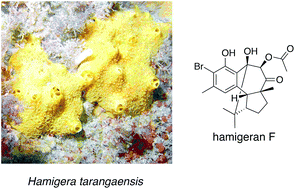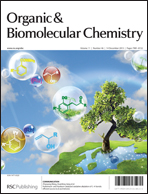Structurally diverse hamigerans from the New Zealand marine sponge Hamigera tarangaensis: NMR-directed isolation, structure elucidation and antifungal activity†
Abstract
The NMR-directed investigation of the New Zealand marine sponge Hamigera tarangaensis has afforded ten new compounds of the hamigeran family, and a new 13-epi-verrucosane congener. Notably, hamigeran F (6) possesses an unusual carbon–carbon bond between C-12 and C-13, creating an unprecedented skeleton within this class. In particular, the structural features of 6, hamigeran H (10) and hamigeran J (12) imply a


 Please wait while we load your content...
Please wait while we load your content...